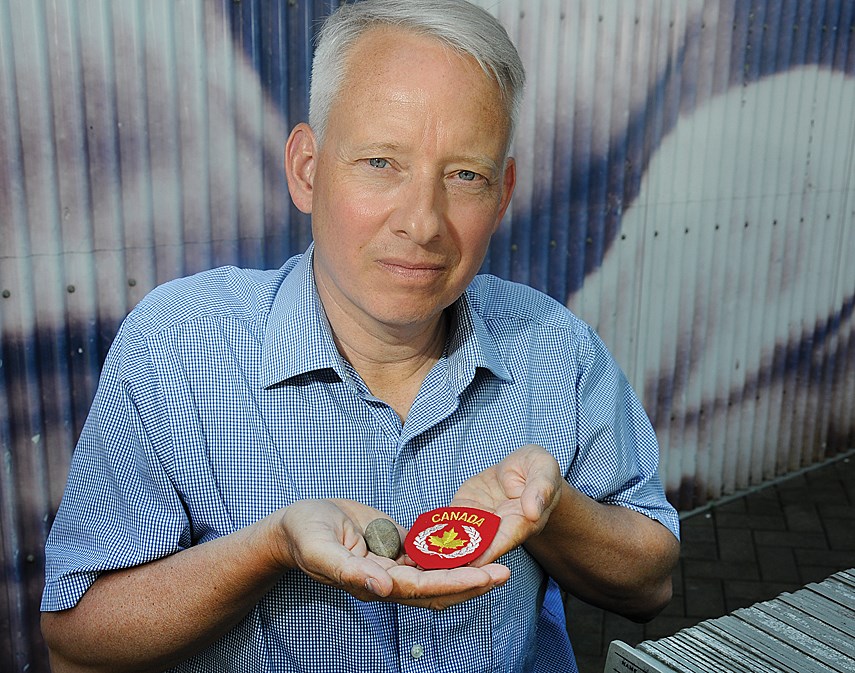North Vancouver’s annual Remembrance Day ceremony was over but for one straggler.
The onlookers, solemn and quiet, turned to walk away from the Victoria Park Cenotaph. Guy Black stayed, looking at the tablet commemorating the North Vancouver resident who died in the Korean War and pondering his name.
The name didn’t stand out because it was distinct. The name stood out because it was the only one there: Donald Hastings.
Who was that?
And just as quickly, Black was struck by a second, more pressing question: “Who remembers him?”
Black, a member of the British Columbia Military Historical Society, resolved to find. It was 2004 and the phone book seemed the most promising route. Black scanned page after page of people with the Sussex surname. Someone must know.
“I was basically phoning everyone in the phone book with the name Hastings,” Black recalls.
Most of the calls were short and fruitless. One woman, her voice thick with too much drink, said something rude and cut the conversation short. She called back the next day and, after offering an apology, identified herself as Hastings’ sister-in-law. It also turned out she’d gone to school with Black’s mother.
Hastings’ brother was in terrible health, she told Black.
“She said it was better not to mention anything to him . . . I think she said it would break his heart,” Black recalls.
But she sent over pictures of Hastings as a child. She sent photos of his parents.
Born in North Battleford, Saskatchewan, Hastings grew up on East Fourth Street and went to North Vancouver High School.
He left school at 16 and joined the Merchant Navy, probably working on the dry dock at the end of the Second World War, Black reasons.
Hastings joined the army in 1949 – one year before Canadian troops were sent to Korea.
“I think he was very adventurous,” Black says, describing Hastings as a good soldier who passed his parachute jump course.
Black found a few of the veterans who’d served with Hastings. More than half a century had rumbled by since then along with hydrogen and then nuclear weapons, Tim Hortons, sushi, miniskirts, rock ‘n’ roll and tiny, ubiquitous screens. But for those that were there, the flashes of memory from the fall of 1952 remained solid, unmoving.
Donald Hastings went on patrol the night of October 15, 1952. In nine months an armistice would be signed and the longest ceasefire in history would begin. But at that point, as historian Steven Casey writes, the conflict had: “bogged down in a bloody stalemate contested over a narrow stretch of land.”
Hastings was on the slope of a ridge when an enemy platoon, “which apparently came on the spot by chance, moved in,” according to Strange Battleground, an account of the war written by Lt.-Col. Herbert
Fairlie Wood.
A soldier ran up to Hasting’s commanding officer, Sgt. J.H. Richardson
Richardson first thought he was one of Princess Patricia’s Canadian Light Infantry, Wood writes.
“I started to ask him what he was up to when he shot me in the stomach . . . so I shot him in the face. All hell broke loose,” Richardson later said, as recorded by Wood.
Hastings was wounded in the firefight. As best as Black can piece together, Richardson did his best to help Hastings get out of there until a grenade exploded.
Both men were wounded.
An explosion had torn a chunk of the ridge and that’s where Hastings was left, just outside the line of fire.
The Canadian artillery pulverized the area. Hastings was never found.
“Next day the Canadians went back and there was nothing,” Black says.
There’s a lot Black could never find out. He doesn’t know if Hastings had any children. He couldn’t track down Hastings’ widow. But he knew enough to make sure Hastings was remembered.
In 2013, the unofficial Lake with No Name on the east side of Mount Seymour Provincial Park officially became Hastings Lake, thanks to Black’s efforts.
North Shore Rescue flew Black to the site by helicopter and mounted a plaque.
It was a fitting tribute, North Shore Rescue’s then-leader Tim Jones said at the time.
“A forgotten lake . . . you never want to go to, a forgotten war you never really knew about and wouldn’t want to go to either and this forgotten soldier,” Jones said. “To me, it was a very appropriate thing for us to be there to support this young man who wants to recognize Donald Hastings.”
Jones gave Black stones from the lake. Those stones were passed to an official who was supposed to take them to Korea but something went amiss, Black says.
“I don’t think he ever did it.”
Black still has a few of those rocks and so, last December, he decided to make the trip himself.
Following a stop at the B.C. legislature on Wednesday, Black is slated to attend a June 24 ceremony at the United Nations Memorial Cemetery in Busan, Korea.
Organizing the ceremony meant co-ordinating with the Canadian embassy in Seoul and dealing with the cemetery’s director.
But Black is determined to finish what began at the Remembrance Day ceremony in 2004.
There’ll be dogwood flowers, poppy wreaths and an honour guard. And Black will open his hand-carved yellow cedar box and take out the Hastings Lake stones – blessed by a priest – and hand them over to a colonel from Hastings’ infantry regiment.
“It’s the end of a journey,” Black says. “I want to do this for him.”
And then, 15 years after standing at the cenotaph, Black can walk away.



